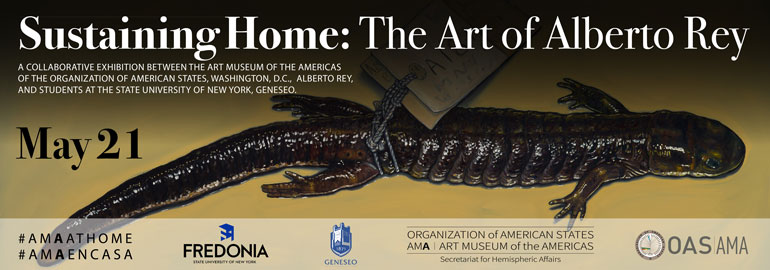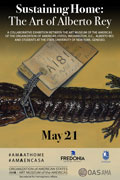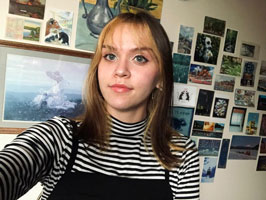
Kyra Krasowski is a senior at Geneseo majoring in psychology and minoring in art history. She says that through her work on this exhibition she has been able to expand her understanding of identity and has been able to become more aware of the complexities of others; and, overall, this has been a great learning opportunity and she is thankful she got to experience it.
On social media June 2, 2021
Lost Beauty II
by Kyra Krasowski
Alberto Rey’s Lost Beauty II is a collection of paintings representative of Rey’s artistic talents and of his thoughtful representations of everyday flora, fauna and artifacts, which have passed from this world in diverse ways. While I personally connect to this collection in its ties to the Western New York State area, I call home, there is also a universal quality to the collection that can be felt by all who experience it. In this series, Rey brought together, in artistic recreation, a series of small objects preserved in the Buffalo Museum of Science's expansive collection. These relics of the past, originally small in size, were given amplified significance by Rey, who painted them in a monumental scale in a gestural style intended to emphasize the significance of the existence. By magnifying these objects to such a large scale, he forces us, as their audience, to acknowledge their significance. Through these paintings we can see the preserved artifacts, as relics, presented to us in a new light that goes beyond their connections to history, as they create ties between our present and our past, grounding us in the environments they once called home. There is a sense of heritage conveyed through the detailed depiction of these preserved relics of our past that could easily be overlooked but is now preserved by Rey’s memorialization of the significance of their existence. The beauty of the collection, preserved in art by Rey, stands as a reminder of the ever-present idea of change and its numerous causes, as we move from past to present and anticipate future changes in our world and its life and created objects.
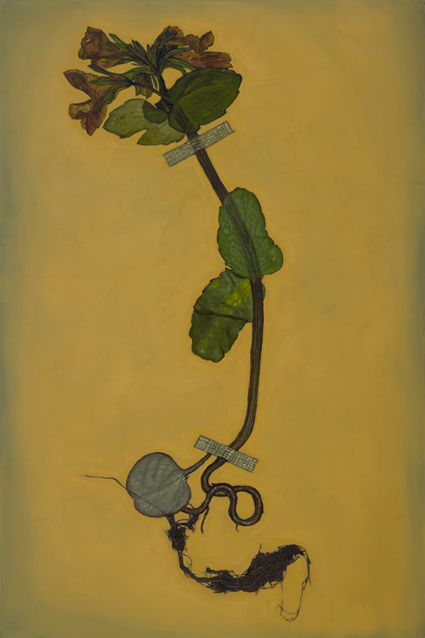
Lost Beauty II: Blue-Eyed-Mary, 2019, Oils on Wood Panel, 96 x 48”, Buffalo Museum of Science, Buffalo, NY
In Blue-eyed-Mary (Extinct), Alberto Rey shows the audience a different side to our preconceived notion of flowers in art, as being decorative and pretty. While many automatically think of still-life or landscape paintings as being lush with color in an exuberant painted life, Rey’s portrayal of these lost flowers subverts such assumptions and shows us a preserved plant, fragile and muted in color. Blue-eyed-Marys are a variety of wildflowers considered to be “extirpated,” and is extinct in some locations such as Western New York State, but is not altogether extinct, as it continues in other areas. Although these flowers still live in some environments, the context of extinction in some places, gives to this flower a quality of witness to environmental changes brought about by climate change. Through his many travels to different places, locally, regionally, nationally and internationally, Rey has crossed paths with numerous species at risk for a similar fate as the Blue-eyed Mary or worse – he has confronted species that are irretrievably gone. While nature is always naturally changing, human environmental damage has accelerated and caused the extinction of significant numbers of species that are not able to be replaced and their loss has damaged our world as such unique species have been lost. Rey’s memorialization of such lost species is a call to action for preservation and a cautionary tale to act to prevent more loss.
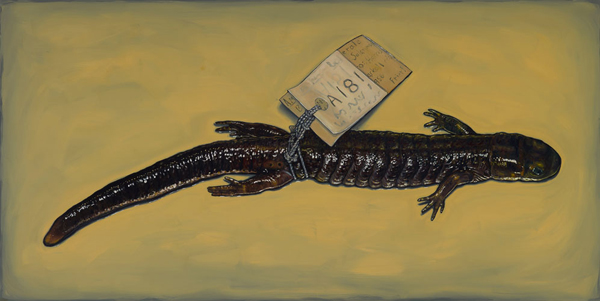
Lost Beauty II: Blue-Spotted Salamander, 2019, Oils on Wood Panel, 36 x 72”, Buffalo Museum of Science, Buffalo, NY
I have great admiration for Alberto Rey’s ability to give life to museum specimens and this is best represented in his Blue-spotted Salamander. His rendition has enabled me to look at this painting and imagine the creature alive and existing in their own environment. Thinking back I most likely have seen this breed of salamanders, as they are native to the area where I grew up but Rey’s painting made me think about it differently, as a creature in need of care. Rey is an artist with many ties to nature, found in his life and in his work, and this series is linked to other series, where nature and environmental concerns are uppermost as themes. In his art and in his life’s pursuits, which include fly-fishing, Rey represents actual and simultaneous engagement with “a nostalgic link to the outdoors,” an element found in this painting. As we look at this work, we experience a breaking down of barriers between the spectator and the subject, as the depicted flower’s situation changes from one of admiration, to a reminder of environmental fragility to a realization of our experiences in nature.

Lost Beauty II: Cicada Type, 2019, Oils on Wood Panel, 36 x 72”, Buffalo Museum of Science, Buffalo, NY
As did Blue-spotted Salamander, Alberto Rey’s Cicada Type will likely produce a similar childhood memory in some who will see Rey’s painting. Although the specific painted cicada, the first documented of its kind, is found in Venezuela and not in New York State, the universal aspects of having individual experiences of encounters with nature, within natural environments, is found in both Venezuela and my own home. No two people will share the same feelings, but everyone has minute details, which they remember and retain, as the ties that bind them to their home and which form their personal and group identity. For those with backgrounds similar to Rey, who has called many different locations a temporary home, there will be an even larger range of connections to their environments and to their formed identities. From Cuba to New York, Rey has crossed paths with numerous examples of this concept that links species to places and to multiple identities past and present and future, as experienced through living organisms. While everyone won't be able to relate to Rey’s work in the same way, everyone can understand the connections he has to his work and his life’s unfolding and can see the same situations in their own lives.
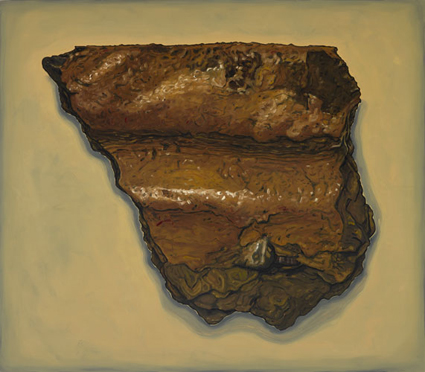
Lost Beauty II: Pottery Sherd, 2019, Oils on Wood Panel, 54 x 48”, Buffalo Museum of Science, Buffalo, NY
Pottery Sherd, another work from Alberto Rey’s series, Lost Beauty II, is a perfect example of remnants that chronicle the evidence left behind that gives witness to human existence in a specific time and place. Pottery Sherd is emblematic - a remnant of what we leave behind, as we alter and shape our environments and the objects that define time and place and home. The shape of the depicted sherd is very natural, one that you can mentally imagine as a whole object, as you envision how the represented piece might have broken from the whole pot to which it once belonged and where and how the whole pot might have fit into a past lifestyle. From his painted pot, Rey has recently moved from painting to the three-dimensional craft of pottery. He often used clay that he harvested from the Canadaway Creek , which flows behind his home and studio, much as the First Nations peoples who lived in the same area in Fredonia, New York did centuries ago. This new artistic venture connects directly to Pottery Sherd, as this creek was the same source of clay they had used 600 to 700 years ago. In considering the subject of Pottery Sherd alongside Rey’s current ceramics in his studio, his work as a potter and the subject of this painting enables us to acknowledge tradition and the timeless and universal activity of creating objects that we use to define our lives, our homes, our environments and our identities. This realization of another omnipresent aspect of existence that impacts our world and our connected lives expressed as a significant theme in Pottery Sherd and Rey’s newly acquired identity as a maker of pots.
Collections in museums provide the audience with information about the time and places of the specimens. In Lost Beauty: II, Alberto Rey took this base level information and infused a new sense of life into what many others would have overlooked. These paintings have a consciousness to them, an awareness of their origins and audience. Each individual work is evidence of an existence that has some way impacted a human being and in so creating this series, Rey has also indicated another way in which he has defined his connection, as a transplanted Cuba, to his home in Western New York State. For the Art Museum of the Americas, which is linked to the environmental goals of the Organization of American States, this exhibition provides an important intersection between museum audiences, issues of sustainability and the art of Alberto Rey.

